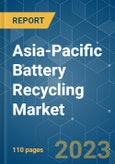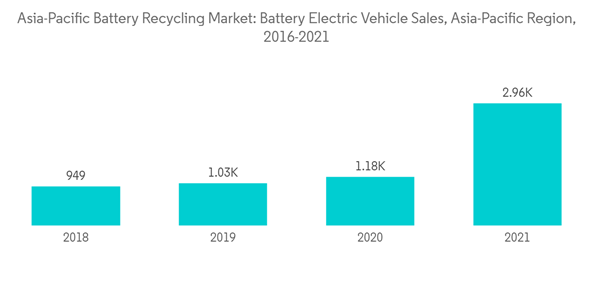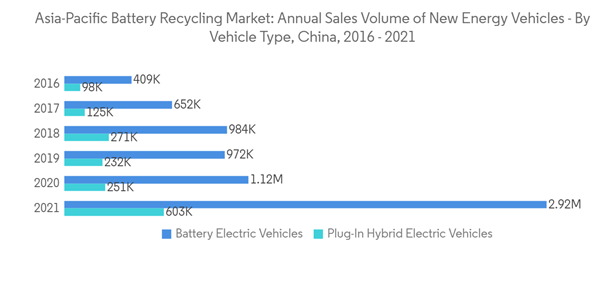Over the medium term, the increasing upcoming investments in battery recycling and the growing battery electric vehicle production and sales are expected to drive the growth of the market studied. On the other hand, the high cost of recycling operations is expected to hamper the growth of the Asia-Pacific battery recycling market during the forecast period.
Nevertheless, product innovation and adaptation of the latest battery recycling technologies are expected to create lucrative growth opportunities for the Asia-Pacific battery recycling market in the forecast period. China is expected to dominate the market and is expected to register the highest CAGR during the forecast period. This growth is attributed to increasing investments and growing battery usage in electric vehicles (EVs).
APAC Battery Recycling Market Trends
Lithium-ion Battery Expected to Witness Significant Growth
Lithium-ion battery technology has recently witnessed colossal popularity, particularly in the automotive (EVs) and renewable power industries. The plummeted prices and good chemistry steered the technology demand. The lifetime of a lithium battery is approximately three to four years, after which the battery users can provide it for recycling and procure a new one.The sales of battery electric vehicles (BEVs) in the Asia-Pacific region in 2021 were around 2.96 million units. The demand for BEVs is driven by climate goals, generally the net-zero carbon emissions targets in all industries. As lithium-ion battery technology is best suited for EV manufacturing, the demand has increased. Such growth will likely give an impetus to the battery recycling market shortly through used-up Li-ion batteries.
In January 2022, Electra, the battery materials manufacturer, agreed with Japanese firm Marubeni to get the black mass derived from the Li-ion battery recycling operations. Electra intends to take advantage of Marubeni's vast network of battery cell recyclers worldwide to secure a stable source of black mass. Marubeni's battery recycling operation is expected to be commissioned in 2023.
Furthermore, in May 2022, ACE Green Recycling (ACE) announced plans to build and operate four new lithium-ion battery recycling facilities with an annual capacity of over 30,000 tons. The company is currently planning for facilities in Thailand, India, and the United States, with planned capacities of 10,000 tons in India and Thailand and 20,000 tons in the United States.
Therefore, the lithium-ion battery segment is expected to witness significant growth during the forecast period.
China to Dominate the Market
The battery recycling industry witnessed continuous growth in China due to the start-ups in the battery recycling field. The other significant drivers for battery recycling are the growing electric vehicles market and energy storage projects in the region.China dominates battery production, holding above 70% of global cell production capacity. It produces about half of all batteries for light-duty vehicles. China also accounts for the largest share of demand at nearly 80 GWh.
According to China Association of Automobile Manufacturers statistics, in 2021, China's annual sales volume of new energy vehicles was 29,16000 units of Battery Electric Vehicles (BEV) and 603000 units of Plug-In Hybrid Electric Vehicles. The growth of electric vehicles is expected to drive the Asia-Pacific battery recycling market during the forecast period.
In June 2021, China-based battery materials producer, GEM Co., announced plans to invest around CNY 310 million in a project to recover nickel and cobalt material (precursor materials) from an existing plant for battery recycling in the Hubei province of China. The company intends to triple its annual precursor production to 100,000 metric tons by 2025.
In October 2021, CATL announced plans to create a USD 5 billion facility to recycle used batteries for their earth materials, such as cobalt and lithium. The facility will be a joint venture at a time when EVs are becoming more and more in demand globally. Furthermore, in July 2022, LG Energy Solution announced plans to establish a battery recycling joint venture in China with the Chinese new energy Li-ion battery material research and development manufacturer Huayou Cobalt. The joint venture will use the infrastructure of Huayou Cobalt to extract nickel, cobalt, and lithium from waste batteries and then supply them to the Nanjing Factory of LG Energy Solution. A post-treatment plant for processing recycled metals will be built in Quzhou, Zhejiang Province, where Huayou Cobalt operates.
Owing to such developments, China is expected to dominate the Asia-Pacific battery recycling market during the forecast period.
APAC Battery Recycling Market Competitor Analysis
The Asia-Pacific battery recycling market is moderately fragmented in nature. Some of the major players in the market (in no particular order) are Exide Industries Limited, GS Yuasa International Ltd, Neometals Ltd, Contemporary Amperex Technology Co. Limited, and GEM Co. Ltd.Additional benefits of purchasing the report:
- The market estimate (ME) sheet in Excel format
- 3 months of analyst support
This product will be delivered within 2 business days.
Table of Contents
Companies Mentioned (Partial List)
A selection of companies mentioned in this report includes, but is not limited to:
- Exide Industries Limited
- GS Yuasa International Ltd
- Neometals Ltd
- Contemporary Amperex Technology Co. Limited
- GEM Co. Ltd
- TES
- ACS Lead Tech
- Umicore Cobalt & Specialty Materials
- NEC Corporation
- Nippon Recycle Center Corp.










